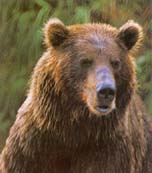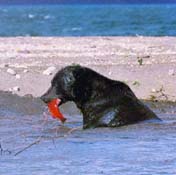The Kamchatka |
 |
Brown Bear |
Nowhere in Siberia could enormous brown bears be found,
but they are very abundant in Kamchatka, home to the densest population of brown bears in the world. Each lake, river and stream is populated by several families of those huge animals. The adult male may weigh up to one ton. They might be comparable to American grizzly bears, though they are not so aggressive and predatory.
When salmon spawning time is near, bears from far and wide come to the rivers. They trample paths through the undergrowth, make themselves places to lie down, and patiently await the arrival of the first fish. 
Early Human Encounters
The first Europeans to come to Kamchatka in the 18th century were surprised by the number of brown bears. Their size (up to 9 feet and 800 pounds in males, and 7 feet and 700 pounds for the females) was alarming, but unlike their Siberian relations they are relatively unferocious. The animals are hunted heavily, chiefly for their fur and gallbladder, highly valued as a medicine in Asia, which at the moment brings in around $25 per gram to Kamchatkan hunters. This is considerable money in an area where an average salary is in the range of $200 per month, and poaching is wide-spread.
Salmon has always been the bear's main diet, the chief source of the supplies of fat which allow it to survive the long, snowy winter. Until the salmon run begins in early summer, the bears are largely vegetarians, feasting on berries and nuts.
Until 200 years ago the bear had hardly any enemies on Kamchatka. The Cossacks were not interested in it, and the Itelmens hunted in moderation, using poisoned arrows. In winter, however, they employed another method: they would thrust small tree trunks and branches into the bear's den. The angry bear would try to clamber over the obstacle, but in doing so dragged the wood further in and found himself caught against the roof of its cave. The hunters would then dig a hole from above and stab the animal.
Modern Bear-hunting
Modern hunters employ a variety of methods for hunting bears. Some track bears with specially trained dogs. The dog ranges far ahead of the hunter, searching for a bear. When it finds a bear, the dog runs in circles around the animal, biting at and annoying the huge creature so that it does not run away. This is very dangerous for the dog, who must avoid the bear's hefty paws, and unsuccesful bear dogs are soon weeded out. Alerted by the dog's barks, the hunter rushes up and shoots the bear.
Bears are also often caught in rope traps. A lasso-like rope loop is hung across a path which bears are known to frequent; its end is tied to a tree. As the bear is walking down the path, he passes through the rope and, as he continues to walk, the lasso tightens around his body. Panicking, he runs ahead, trapping himself still more. Eventually he becomes so wrapped up in the rope that he can no longer move. When the hunter comes by in a day or two to check his trap, he finds the immobilized bear and shoots it.
Home | Bears | Salmon | Fishing | Petropavlovsk | Military | Volcanos | Village Life | Visiting | NGOs | Books


